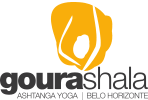The Ashtanga Yoga method is based on three points that complement and integrate each other. They are called Tristhana, which derives from the term trini three.
Breathing is first and the soul of the whole approach. A free, long, nasal-only breath. The lips remain together, allowing a long and free breath, without holding back. An important detail to be emphasized is the non-retention in the practice of asanas, in the whisper breathing method, a slight whisper is produced in the throat while the air passes through the inhale and exhale with the glottis contracted. And no retention. Air is not trapped during asana practice.
Asana is the second very important aspect in Ashtanga Yoga, the structure of the body needs to be close to a reasonable alignment so that the body is not exposed to injury, and the therapeutic effect is effective. Learning from an experienced teacher and representative of parampara (legacy or discipleship) is very important for the benefit of the practitioner.
And finally the Drsti (eye focus). Keeping our eyes on one point allows us to be more present during the execution of the asanas, reflecting directly on introspection, and meditation during our asana practice, in the end, the method is still a movement meditation.
Here are the focal points:
Urdve Dristh, look up
Brumadhye Dristh, look at the center of the forehead
Nasagre Dristh, look at the tip of the nose
Parsvayoh Dristh, look left/right
Nabhou Dristh, look at navel
Hastagre Dristh, look at the fingers
Angusthagre Dristh, look at the thumb
Padagre Dristh looking at his toe


